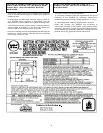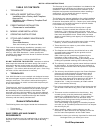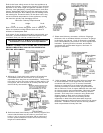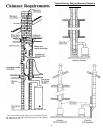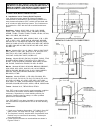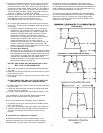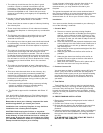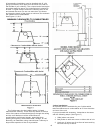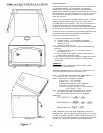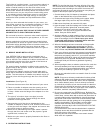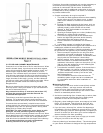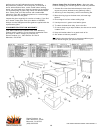8
1. The chimney should have a fire clay liner in good
condition. Loose or cracked liner sections can be
hazardous. If the chimney does not have a liner, one can
be installed by a qualified professional. Some metal
liners are acceptable to use. Check with your stove
dealer or local building code agency for acceptability of
these liners.
2. No part of the chimney should have any leaks, missing
masonry, cracks, loose mortar or soft mortar.
3. There should be no mortar or parts of chimney blocking
the chimney flue.
4. There should be a minimum 2-inch clearance between
any part of the fireplace or chimney and any combustible
materials.
5. The fireplace and chimney should be built on a solid
concrete footing supported by the ground and not
attached to the house.
6. The chimney must have a good natural draft and should
be self-starting. A chimney that has a poor draft and is
subject to draft reversal should be repaired or replaced
before using.
7. The chimney should be the proper size. Some fireplace
chimneys are quite large and will cause poor stove
performance and excessive creosote. The rule of thumb
is that the chimney flue should be roughly no more than
three times the flue opening on the stove. A 6-inch stove
flue will work in a 8-inch by 12-inch fireplace flue. It may
be necessary to install another liner in an oversized
chimney.
8. The chimney should extend at least 3 feet above the
roof and at least 2 feet above any point of the roof within
10 feet.
9. This stove must be used alone in the chimney. Any
unused opening must be permanently sealed with
masonry by a skilled brick mason. A clip-in type flue
cover is not acceptable for this use because of the
likelihood of it coming loose during a chimney fire and
possibly spreading the fire.
10. The stove may be installed using a masonry relining
system or metallic chimney or metallic relining
system that meets or exceeds UL 1777.
11. The Cricket is approved for installation with Class “A”
pipe.
Your local building Code agency or Fire Safety inspector
can refer you to a qualified professional who can inspect
your chimney for you.
Remember to have your chimney inspected for leaks
and blockage before you install your stove.
Installation into a masonry fireplace is very similar to
installation into a factory-built fireplace.
CAUTION: Before using the Cricket, or any other
woodstove with a 6" flue, it is critical to first determine
if the chimney is lined and that the liner is neither too
small or too large for the stove you wish to use. Either
your SIERRA woodstove dealer or a qualified chimney
sweep should first inspect your chimney.
If your chimney is lined with a clay tile liner which is no
smaller than 6" x 6" or larger than 8" x 12" inside
measurements, you may install the Cricket in your
fireplace.
The general accepted rule is the cross-sectional area of
the chimney should be no more than three times the cross-
sectional area of the flue exit of the stove. The cross-
sectional area of a 6" flue or your Cricket is 28 sq. inches.
Installation:
Your stove must be directly connected to your chimney in
one of the following 3 methods:
1. Ceramic Wool
A. Remove or secure open the existing fireplace
damper. Install a section of flexible pipe through the
damper, up the chimney at least ½ the way up the
first chimney liner. Oval or round pipe may be used,
if oval pipe is used you will need to adapt it to the 6"
flue collar of he stove.
B. Pack the area around the pipe and the damper area
or the chimney liner with ceramic wool. Make sure it
is packed tight so no air can go between the pipe
and chimney liner.
C. Adjust the pipe to the approximate height of the flue
collar on the stove.
D. Slide the pipe down into the flue collar as far as
possible.
E. Slide the pipe down into the flue collar as far as
possible. Secure te pipe to the flue collar with at
least three metal screws.
F. Make sure the ceramic wool is still in place and no
heat from the stove can fo up the chimney.
2. Positive Connect Kit
You may want to obtain a “positive connect kit” from you
dealer. They are made of metal and are designed to
close off the entire upper part of your fireplace allowing
only the stove pipe to exit up the chimney. Normally
these kits are not offered to or intended for the do-it-
yourselfer.
3. Total Reline
Total relining of your chimney may be required where
the existing chimney is too large to draw properly or does
not have a clay chimney liner. Total relining is normally
beyond the expertise of the best do-it-yourselfer, and we
urge you to have your dealer or a certified chimney sweep
do it for you.
III. FREESTANDING INSTALLATION
1. Remove the hardware package taped to the inside of
the pedestal.
2. Position the Cricket on top of the pedestal.
3. Be sure that the holes in the brackets on the stove line
up with the notched brackets on the insides of the
pedestal.
4. Using the hardware provided (nuts, bolts, and washers),
secure the stove to the pedestal by running the bolts
through the stove bracket holes and installing washers
and nuts.
IT IS IMPORTANT THAT THE STOVE BE TIGHTLY
BOLTED TO THE PEDESTAL.




